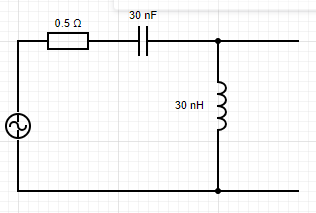
Hello! I have an device which is equivalent circuit is RC as follows in the image I shared: R is supposed to be 0.5Ω and C supposed to be 30nF, but it can vary a little bit between device to device. I cannot touch the leg between the capacitor and the resistor!
While I can measure the capacitor value pretty accurate with LCR meter the resistor reading is off...way off
I tried to find way I could get a hold of the resistor magnitude and it came across my mind that if ill add an inductor in series and If I can work at resonance in the range my signal generator works, 30 MHz, then I could find the value of the resistor or atleast I could know the difference between 0.5Ω to 1Ω. This is the circuit I draw with the values I picked.
Using the signal generator with a steady sine wave, I found out the resonance frequency was more than double that I calculated. I guess it was because of parasitic capacitance and inductance in the BNCs I used.
But what bothered me more was even though I found the resonance frequency the gain was only 5 times greater then the voltage input. Moreover at this point I found out I didn't know how to translate the results to find the resistors value.
I solved the circuit for steady state as follows:

Now the only way this have a chance to be a logic value is if L\K-L >0 . This means that must be k<0. But as I mentioned earlier the gain in scope was of order of 5 ... k=5. I tried to put all that data inside the equations (Fres,S=2*pi*F;L,C) but no matter what I get a negative value for R.
Can you tell me where I am wrong? Because I can't see error in the way I solved the transfer function or in the way I solved the parametric equation.
Also do you guys got any suggestions in how can I measure the resistor? I need a practical idea as I don't have a 30 GHz spectrum analyzer. I got LCR meter, normal scope, and a signal generator which can generate up 30 MHz.
EDIT: Only now I noticed I had a mistake in the capacitor value which is 30nF! I will fix it yet the problem in the equations remains unsolved. Why I am getting a mathematics error and how can it be explained? RLC equations is good , and k is suppose to be greater then 1 in resonance so why from the equation it comes that it can only be solved when k is < 1?
